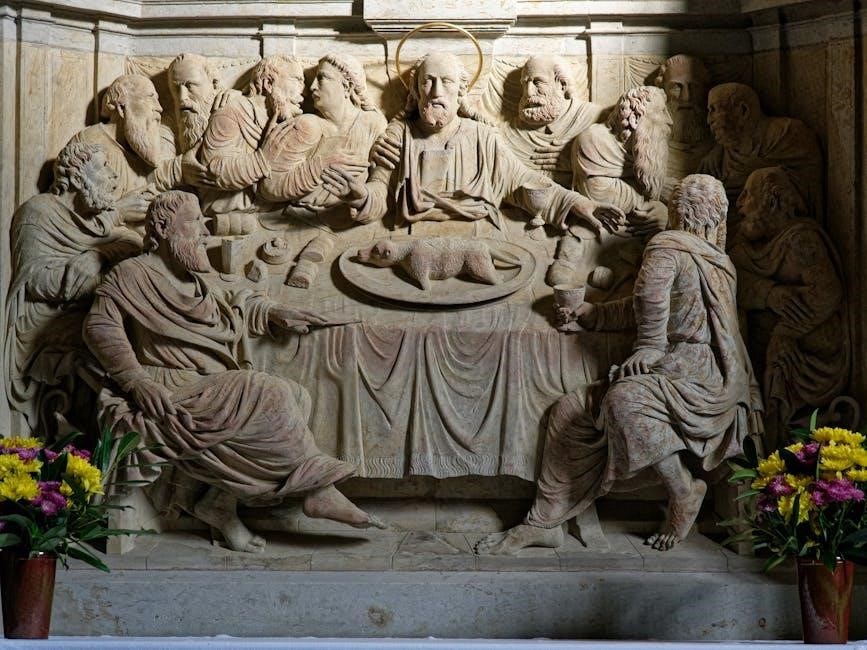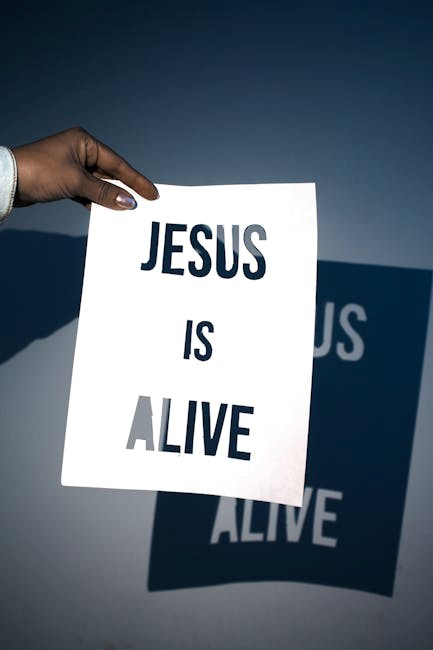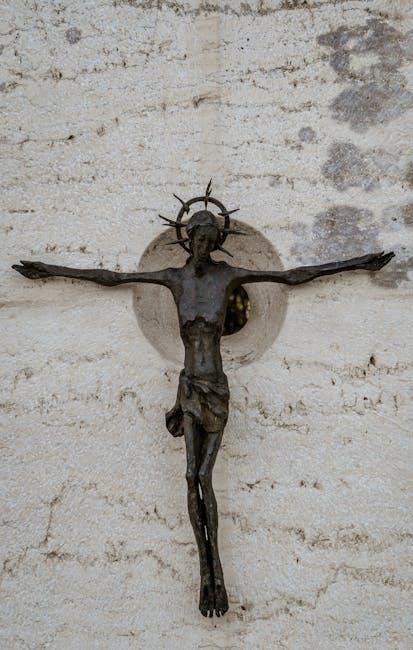Holy Week, or Passion Week, commemorates the final days of Jesus’ earthly ministry, from Palm Sunday to Easter. This sacred period reflects His sacrifice, resurrection, and redemption, fulfilling biblical prophecies and Jewish traditions like Passover.
Overview of Holy Week
Holy Week, also known as Passion Week, is a sacred period commemorating the final days of Jesus’ life on Earth. It begins on Palm Sunday, marking Jesus’ triumphal entry into Jerusalem, and concludes on Easter Sunday, celebrating His resurrection. This week is divided into significant events: Monday’s cleansing of the Temple, Tuesday’s challenges to His authority, Wednesday’s preparations for the Last Supper, Thursday’s institution of the Eucharist, Friday’s crucifixion, and Sunday’s resurrection. These days reflect Jesus’ journey from celebration to sacrifice, emphasizing themes of redemption, forgiveness, and divine love. Holy Week is central to Christian faith, offering a profound reflection on Jesus’ mission and its eternal impact.
Historical and Biblical Significance
The last week of Jesus’ life holds profound historical and biblical significance, marking the culmination of His ministry and the fulfillment of Old Testament prophecies. This period, known as Holy Week, encapsulates the events leading to His crucifixion and resurrection, which are central to Christian theology. Jesus’ teachings, miracles, and interactions during this week, as recorded in the Gospels, underscore His divine mission and humanity. The week’s events, from the Triumphal Entry to the Resurrection, are deeply rooted in Jewish traditions and the Passover narrative, symbolizing redemption and salvation. Historically, this week reshaped the course of human history, establishing the foundation of Christianity and inspiring countless followers to embrace His message of love and forgiveness.

Daily Events of Holy Week
Holy Week chronicles Jesus’ final days, from His triumphal entry into Jerusalem to His resurrection. Each day holds significance, reflecting His mission, sacrifice, and divine purpose.
Saturday: Arrival in Bethany
Jesus arrived in Bethany, where a supper was prepared in His honor. This event marked the beginning of Holy Week, setting the stage for the triumphal entry into Jerusalem. Lazarus, whom Jesus had raised from the dead, was present, symbolizing Jesus’ power over death. The gathering in Bethany highlighted the growing tensions and anticipation surrounding Jesus’ final days. This day was a moment of calm before the tumultuous events that would unfold, showcasing Jesus’ divine purpose and the preparations for His ultimate sacrifice.
Sunday: Triumphal Entry into Jerusalem
On Sunday, Jesus made a triumphant entry into Jerusalem, riding a donkey as a symbol of peace and humility. Crowds welcomed Him with palm branches, shouting “Hosanna,” recognizing Him as the Messiah. This event, known as Palm Sunday, marked the beginning of Holy Week and fulfilled biblical prophecies. Jesus’ entry was a deliberate act to present Himself as the King of Israel, embodying God’s plan of redemption. The crowd’s celebration contrasted with the growing opposition from religious leaders, setting the stage for the events leading to His crucifixion. This day symbolized Jesus’ divine authority and the people’s hope for salvation, while also highlighting the tensions that would unfold in the coming days. The Triumphal Entry remains a powerful symbol of Jesus’ mission and kingdom.
Monday: The Fig Tree and Temple Cleansing
On Monday, Jesus cursed a fig tree for its barrenness, symbolizing God’s judgment on spiritual hypocrisy. The tree withered, teaching His disciples about faith and prayer. Later, Jesus cleansed the Temple, driving out merchants and money changers, restoring it as a house of prayer. This act enraged religious leaders, who saw it as a challenge to their authority. The fig tree’s withering and the Temple cleansing highlighted Jesus’ divine authority and His call for authentic worship. These events intensified the conflict with Jewish leaders, setting the stage for His eventual arrest. The day underscored themes of judgment, purification, and the true purpose of worship, aligning with His mission to bring spiritual renewal.
Tuesday: Jesus’ Authority Challenged
Tuesday marked a day of intense confrontation as Jewish leaders questioned Jesus’ authority. The Sanhedrin demanded to know by what power He acted, prompting Jesus to respond with parables, such as the Parable of the Tenants, condemning their rejection of God’s messengers. He also faced debates over paying taxes to Caesar, cleverly answering, “Render to Caesar the things that are Caesar’s, and to God the things that are God’s.” These exchanges highlighted Jesus’ wisdom and divine authority, leaving His opponents in awe. The escalating tensions on this day set the stage for the plot to arrest Him, as religious leaders sought to silence Him. This day emphasized Jesus’ unwavering commitment to His Father’s will, despite growing opposition.
Wednesday: Preparation for the Last Supper
Wednesday of Holy Week is often referred to as a day of quiet preparation. Jesus and His disciples were likely in Jerusalem, finalizing arrangements for the Passover meal. According to some accounts, Judas Iscariot met with the Sanhedrin to betray Jesus, agreeing to hand Him over for 30 silver coins. Meanwhile, Jesus focused on preparing for the Last Supper, a pivotal moment in His ministry. The disciples were instructed to secure a room where they could eat the Passover together, symbolizing the covenant between God and His people. This day underscores the contrasting themes of betrayal and divine purpose, as Jesus readied Himself and His followers for the sacred meal that would commemorate His sacrifice and establish the New Covenant.
Thursday: The Last Supper
Thursday marks the day of the Last Supper, a deeply significant event in Jesus’ life. Jesus and His disciples gathered in a specially prepared room in Jerusalem to observe the Passover. During the meal, Jesus instituted the Eucharist, breaking bread and offering wine as symbols of His body and blood, signifying the New Covenant. He also washed the disciples’ feet, demonstrating humility and servant leadership. This intimate moment was overshadowed by the announcement of betrayal, first by Judas Iscariot, who agreed to hand Jesus over to the authorities. The supper concluded with Jesus praying and preparing His followers for His impending departure. This sacred meal remains a cornerstone of Christian worship and reflection, embodying sacrifice, love, and redemption.
Friday: Crucifixion and Burial
On Friday, Jesus was crucified on Golgotha, a hill outside Jerusalem, at the third hour (9:00 AM). This act of sacrifice was a fulfillment of biblical prophecies and represented the ultimate act of love and redemption. Jesus endured immense physical and spiritual suffering, offering His life to atone for humanity’s sins. At the ninth hour (3:00 PM), He gave up His spirit, symbolizing the completion of His mission. Following His death, His body was taken down and buried in a nearby tomb in the garden of Joseph of Arimathea. This event marked the culmination of the Passion Week, setting the stage for the resurrection on Sunday. The crucifixion and burial are central to Christian theology, embodying themes of sacrifice, forgiveness, and redemption.
Sunday: Resurrection
Easter Sunday marks the resurrection of Jesus, a pivotal event in Christian faith. Early morning, women discovered the empty tomb, finding angels who announced Jesus’ victory over death. This miracle fulfilled prophetic promises and demonstrated His divine power. The resurrection signifies eternal life and hope, transforming the sorrow of His followers into joy. It is celebrated as a triumph of redemption and the foundation of Christianity. The resurrection underscores the essence of Holy Week, highlighting forgiveness and eternal salvation through Jesus’ sacrifice. This day is a celebration of renewal and faith, commemorating the ultimate expression of God’s love and mercy. The resurrection remains central to Christian belief, inspiring hope and perseverance worldwide.

Theological Themes in the Passion Week
The Passion Week highlights themes of sacrifice, redemption, and forgiveness. Jesus’ death and resurrection demonstrate divine love, mercy, and the power to overcome sin and death.
Sacrifice and Redemption
Jesus’ final week embodies the ultimate act of sacrifice, as He willingly surrendered His life for humanity’s redemption. The crucifixion, occurring during Passover, symbolized Jesus as the Lamb of God, fulfilling ancient Jewish traditions. His death at the 3rd hour mirrored the morning sacrifice, while His final breath at the 9th hour aligned with the evening sacrifice, emphasizing divine fulfillment of prophecy. This sacrifice erased sin’s debt, offering eternal forgiveness and reconciliation with God. The resurrection on Easter Sunday confirmed victory over death, sealing redemption for all believers. Through this, Jesus demonstrated unparalleled love, mercy, and the power to transform humanity’s spiritual state, making Holy Week the pinnacle of Christian theology and devotion.
Forgiveness and Mercy
Central to Jesus’ final week is the theme of forgiveness and mercy, culminating in His ultimate act of love. During the Last Supper, Jesus instituted the Lord’s Supper, symbolizing His body and blood as a sacrifice for sin. His prayer in the Garden of Gethsemane, “Father, forgive them,” exemplified divine mercy. Even on the cross, Jesus extended forgiveness to His tormentors, demonstrating unparalleled grace. This emphasis on forgiveness reflects His teachings throughout His ministry, calling believers to love and pardon others. The Passion Week highlights how Jesus’ sacrifice embodied God’s mercy, offering humanity redemption from sin and eternal reconciliation. His actions and words continue to inspire believers to embrace forgiveness as a cornerstone of their faith and relationships.

Cultural and Historical Context
The last week of Jesus’ life is deeply rooted in Jewish traditions like the Passover and set against the backdrop of Roman governance in Jerusalem.
Jewish Traditions and the Passover
The last week of Jesus’ life is intricately connected to Jewish traditions, particularly the Passover. The Passover commemorates Israel’s liberation from Egypt, symbolizing redemption and divine deliverance. Jesus’ arrival in Jerusalem coincided with the Passover festival, drawing large crowds. The Last Supper, a pivotal event, was a Passover meal where Jesus reinterpreted the symbols of bread and wine, linking them to His body and blood. This act underscored His role as the ultimate sacrifice for humanity’s redemption; Jewish customs, such as the triumphal entry and the cleansing of the Temple, align with the biblical narrative of Jesus fulfilling prophetic expectations. The interplay of Jewish traditions and Jesus’ actions highlights the theological significance of His mission and the climax of His earthly ministry.
Roman Influence in Jerusalem
During Jesus’ final week, Roman authority heavily influenced Jerusalem. Pontius Pilate, the Roman governor, maintained control through military presence and political maneuvering. The city’s volatile atmosphere, especially during Passover, necessitated heightened Roman vigilance to suppress potential uprisings. Jesus’ teachings and actions, such as the Temple cleansing, drew attention from both Jewish leaders and Roman officials, who viewed Him as a threat to stability. The collaboration between Roman and Jewish authorities led to Jesus’ arrest and trial, culminating in His crucifixion—a Roman method of execution. The interplay of Roman power and Jewish religious tensions shaped the events of Passion Week, highlighting the political dimensions of Jesus’ sacrifice and resurrection.

Modern Resources for Study
PDF guides, Bible charts, and reflection materials provide detailed insights into Jesus’ final week. These resources offer maps, timelines, and scriptural analysis for deeper understanding and devotion.
PDF Guides and Study Materials
Various PDF resources offer comprehensive insights into the last week of Jesus’ life, providing detailed timelines, scriptural references, and historical context. Guides like “Jesus Last Week — The Passion Week” by Barnes Bible Charts outline daily events, from the Triumphal Entry to the Resurrection. These materials include maps of Jerusalem during Jesus’ time, helping visualize key locations. Devotionals and reflection guides are also available, offering scripture readings and prayers for each day of Holy Week. Additionally, family-friendly resources include printable Holy Week schedules and activities to engage all ages. These study materials are invaluable for personal or group devotion, enhancing understanding and deepening spiritual reflection during this sacred period.